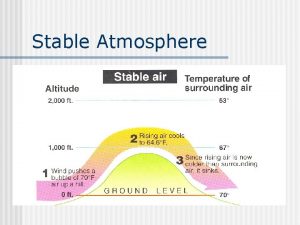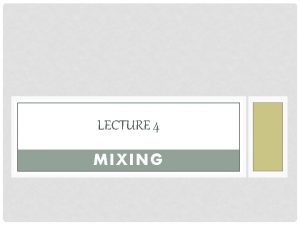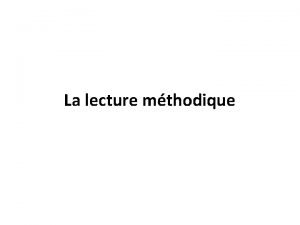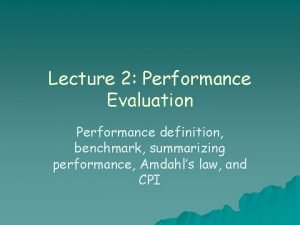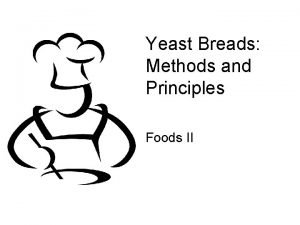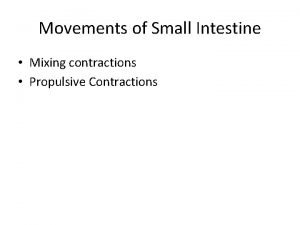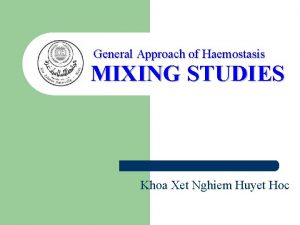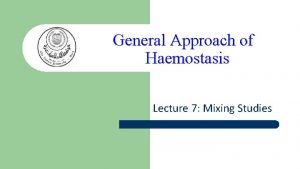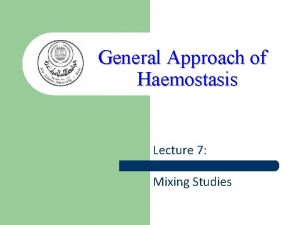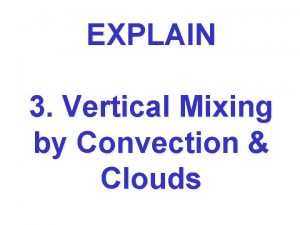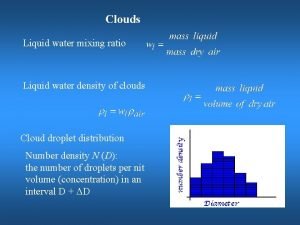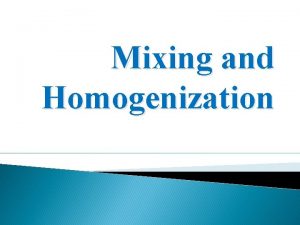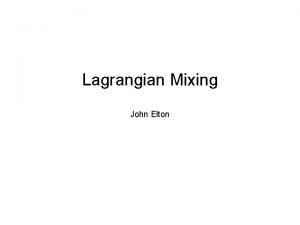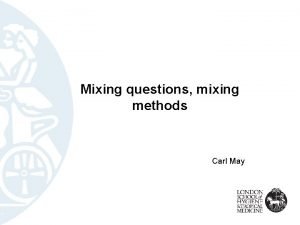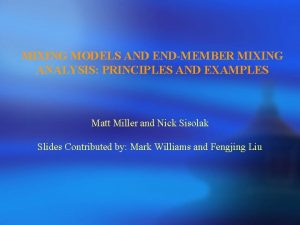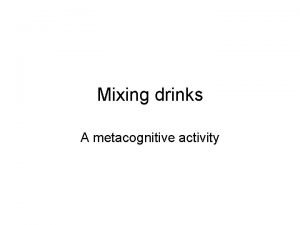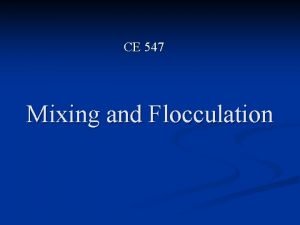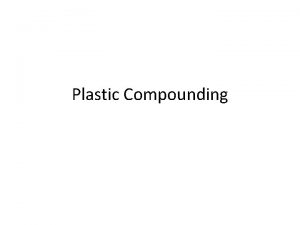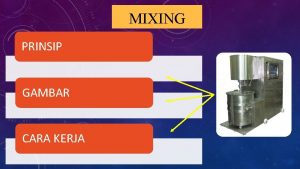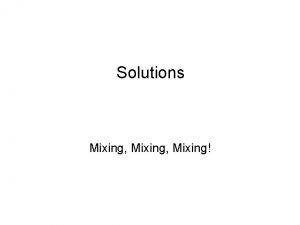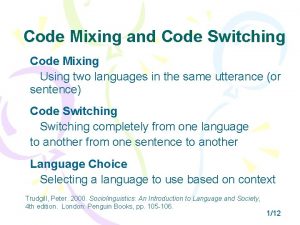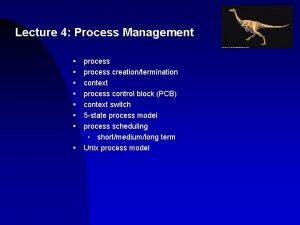LECTURE 4 MIXING DEFINITION Mixing a process that
































- Slides: 32

LECTURE 4 MIXING

DEFINITION Mixing a process that results in a randomization of dissimilar particles within a system.

A- Flow characteristics Depending upon relationship between shear rate and the applied shear stress, the fluids may be divided into: v. Newtonian Fluids v. Non-Newtonian Fluids

IMPORTANT DEFINITIONS •



2 - MIXING MECHANISMS

1. BULK TRANSPORT The movement of relatively large portion of material being mixed from one location in the system to another. Bulk transport (rearrangement or permutation) Accomplished by means of paddles, revolving blades, or other devices within the mixer arranged so as to move adjacent volumes of fluid in different direction (3 D shuffling).

2. TURBULENT MIXING It is a direct result of turbulent fluid flow which is characterized by a random fluctuation of the fluid velocity at any given point within the system. The fluid velocity at a given instant may be expressed as the vector sum of its component in the X, Y and Z direction. In turbulent flow, the fluid has a different instantaneous velocities at different location at same instant in time.

Turbulent flow visualized as (eddies) with various sizes [portion of fluid moving as a unit in a direction contrary to that of general flow]. Larger eddies breakup forming smaller and smaller size eddies until are no longer distinguished. Size of distribution of eddies with turbulent region known as (scale of turbulence). Note: 1. Turbulence come from: Difference between temporal and spatial velocity within a body of fluid Randomization of fluid particles Mixing 2. Intensity (additional characteristic for turbulent flow) related to velocity of moved eddies.

3. LAMINAR MIXING Streamline or laminar flow is frequently encountered when highly viscous fluid are being processed. [occur with gentle stirring and adjacent to stationary surfaces in vessels where turbulent flow is predominant]. Occur when two dissimilar liquids are mixed through laminar flow, the shear generated stretches the interface between them. If the mixer employed folds, the layers back upon themselves, the no. of layers and hence the interfacial area increase exponentially with time.

4. MOLECULAR DIFFUSION Mixing at the molecular level by diffusion resulting from thermal motion of molecules. Occurs in conjugation with laminar flow that tends to reduce sharp discontinuities at the interface between the fluid layers. Sufficient time Complete mixing

MOLECULAR DIFFUSION FOLLOWS: FICK’S FIRST LAW • Conc. Gradient decrease with time as mixing complete Effect by Fluid viscosity Size of diffused molecules

5. SCALE AND INTENSITY OF SEGREGATION Quality of mixture judged upon random distribution of their components. Bulk transport, turbulent flow and laminar flow Intermingling of lumps of liquid to be mixed Size and shape of lumps depend on 1. Mechanism contribute to overall process 2. Time of mixing While molecular diffusion discontinuously of lumps from one to next (lumps retains constant and uniform internal composition) Liquid, gas and powder eliminate conc. gradients between lumps

NOTE: DANCKWERTS (DEGREE OF MIXING QUANTITIES) 1. Scale of segregation (scale of turbulence) Expressed in 2 ways Linear scale Average value of diameter of lump Volume scale Average lump volume 2. Intensity of segregation Measures variation in composition among various portions of mixture (reaches zero when mixing complete)

6. TIME DEPENDENCE Mechanisms that are active in mixing and are relative to the proceed in mixing process. E. g. Diffusion is necessary for effective reduction of intensity of segregation to reach zero when time of mixing is complete.

EQUIPMENT A. Batch Mixing is limited in volume contained in suitable mixer (most feasible) Parts of mixer: 1 - Tank or container (hold the material being mixed) 2 - energy supplier (for rapid mixing) A- main (impeller, air stream, liquid jet) [direct flow of material within vessel] B- sub. (baffles, vanes, ducts) [bulk movement of material in mixer so increase efficiency].

1. IMPELLERS (PUSHERS) Types depend on: Single or in combination 1 - type of flow (radial, axial, tangential–touchable-) 2 - shape and pitch of blades

BLADES OF PROPELLERS (FANS) 1 - Propellers: (produce flow parallel to their axis) - High efficient with low viscosity liquids 2 - Turbines (produce axial or tangential flow or combination). Distinguish from propellers: blades don’t have constant pitch throughout their length.

IN TURBINES: 1 - Radial-tangential flow (A, B): turbines with blades set as 90 degree angle to shaft. 2 - Axial flow (C, D): turbines with tilted [not straight] blades (rugged design) Used for very viscous fluids (1000 times more viscous than propeller can be used).

3 - Peddles

2. AIR JETS

3. FLUID JETS

4. BAFFLES Bulk transport is important in initial mixing when segregation present on large scale. Intermingling between materials from remote regions in the mixer. Note: Baffle plates directing flow of fluid and depends largely on type of agitator.

B. CONTINUOUS MIXING Benefits: 1 - freshly mixed materials 2 - very large volume of materials. Accomplished in two ways 1 - Tubes or pipes (very little back flow or recirculation) 2 - Chamber (holdup or recirculation)

1 - Mixing tube (having vanes, baffles, screws, grids or combinations) - Mass transport direct with primary flow - Lack of recirculation - Conc. Gradient along the pipe (tube) 2 - Mixing tank (when input rate difficult to control and fluctuations are unavoidable) Avoided in final mixture by dilution of material in tank

IMPORTANT NOTE: Avoiding fluctuation in conc. and having same holdup: 1 - using series of tanks with half volume. 2 - turbine agitated tank (having vertical sidewall baffles and turbine impeller in middle of tank) thus form 2 regions of mixing [above and below impeller for transport of materials between zones].

MIXER SELECTION Factors for selection: 1. Physical properties of material to be mixed (density, viscosity and miscibility). 2. Economic consideration regarding processing (time for mixing and powder expenditure). 3. Cost of equipment and its maintenance.

GENERAL GUIDELINES FOR MIXER SELECTION 1. Monophase systems (viscosity and density of fluid) effect Type of flow and nature of mixing mechanisms E. g. A- Low viscous fluids (turbulent and circulate mass of material) Air jets, fluid jets and high speed impellers. B- Thick creams, ointments and pastes (high viscosity) [laminar , bulk mixing and molecular diffusion] Turbine of flat blade

2. Polyphase systems Composed of several liquids or solids Subdivision or deaggregation One or more phase formed Dispersals of mass material (process of mixing is homogenization, suspension formation and emulsification) E. g. Mixing of two immiscible liquids requires subdivision of one of the phases into globules distributed throughout bulk of fluid.

NOTES: 1. Selection of equipment Depend on (viscosity of liquids and mechanism of intense shearing force generated). 2. Mixing finely divided solids with low viscosity liquid to produce (suspension) Depend on separation of aggregates into primary particles and then distribution throughout the fluid.

 Phân độ lown ngoại tâm thu
Phân độ lown ngoại tâm thu Block nhĩ thất độ 2 mobitz 1
Block nhĩ thất độ 2 mobitz 1 Thể thơ truyền thống
Thể thơ truyền thống Thơ thất ngôn tứ tuyệt đường luật
Thơ thất ngôn tứ tuyệt đường luật Walmart thất bại ở nhật
Walmart thất bại ở nhật Tìm vết của mặt phẳng
Tìm vết của mặt phẳng Con hãy đưa tay khi thấy người vấp ngã
Con hãy đưa tay khi thấy người vấp ngã Tôn thất thuyết là ai
Tôn thất thuyết là ai Gây tê cơ vuông thắt lưng
Gây tê cơ vuông thắt lưng Sau thất bại ở hồ điển triệt
Sau thất bại ở hồ điển triệt 01:640:244 lecture notes - lecture 15: plat, idah, farad
01:640:244 lecture notes - lecture 15: plat, idah, farad Stable atmosphere definition
Stable atmosphere definition Propeller mixer definition
Propeller mixer definition Les dictions
Les dictions Syntactical expressive means and stylistic devices
Syntactical expressive means and stylistic devices Lecture méthodique définition
Lecture méthodique définition Definition of lecture method
Definition of lecture method Wbb99
Wbb99 Soft medium dough examples
Soft medium dough examples Mixing in warehousing
Mixing in warehousing Ramco super plaster mixing ratio
Ramco super plaster mixing ratio Mixing of thymol and menthol
Mixing of thymol and menthol What are the nutritional contributions of yeast breads?
What are the nutritional contributions of yeast breads? Quattro mix
Quattro mix Herbicide mixing cheat sheet
Herbicide mixing cheat sheet Peristaltic contraction
Peristaltic contraction What is a mixing study
What is a mixing study What is a mixing study
What is a mixing study Aptt mixing study
Aptt mixing study Conditionally unstable atmosphere
Conditionally unstable atmosphere Cutting and mixing food items examples
Cutting and mixing food items examples Water mixing ratio
Water mixing ratio Magma mixing
Magma mixing











